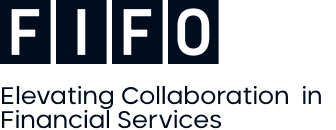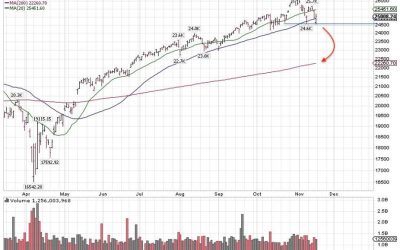by Gary Alexander
November 18, 2025
About a century ago, several major financial magazines were born, beginning with two major journals named after their founders: (1) First, B.C. Forbes (1880-1954), born in Scotland, created “Forbes” Magazine in 1917, and it has continued for over 108 years under son Malcolm Forbes and his son Steve. Then, (2) in 1921, Clarence Barron (1855-1928) formed “Barron’s,” a weekly Dow Jones supplement to their Wall Street Journal. Then, (3) in mid-1929, with perfect contrarian timing, Henry Luce (1898-1967) formed “Fortune” Magazine to complement his “Time” news magazine (1923). And finally, McGraw-Hill launched “Business Week” in the exact week of the market’s peak, just two months after Fortune began publication, just as most major Wall Street fortunes were about to go into a decade of extinction.
I bring this up now, since mass market magazines have always been a fairly reliable contrarian indicator. Last April, when all the market averages were in the dumpster and sentiment reached multi-year lows, The Economist came out with four straight bearish covers, a sort of supercharged level of unreasonable fear. I made this the cornerstone of my April 29th column, printed just over six months ago. Check it out:
See: 4-29-25: Downbeat Sentiment (and Magazine Covers) are Contrarian Buy Signals – Navellier
In that piece. I showed four-consecutive Economist covers in April 2025. All four were strongly bearish:
I also cited the bearish readings by the American Association of Individual Investors (AAII) weekly polls:
Last April, the bears-to-bulls ratio was over 2-to-1 each week, with President Trump’s “Liberation Day” (April 2) showing the largest bearish reading. Also in April, AAII investors were asked: “How has your sentiment toward the stock market changed since the start of the year?” The majority were bearish and a plurality of 81.3% were either “more bearish” or “more cautious” than they were at the start of 2025:
I was not certain of what would happen next, but I study history, so I expected a strong rally. In that article, I shared my expectation that “the rest of 2025 and early 2026 could stage a recovery.”
The S&P’s bottom came on April 8th, at 4,982.77, so last Friday’s close at 6,734.11 reflected a 35% rise in just over six months, and NASDAQ has risen 50% in the same six months. Pretty impressive, but you wouldn’t have expected that if you followed magazine covers, or the super-bearish AAII sentiment poll.
Is the AAII survey a contrary indicator? In market extremes, the historic answer seems to be yes. In the worst market disaster of this century, the Great Financial Crisis of 2008, the number of bearish investors in the survey spiked above 60% in the final months of that crash, when stock plunged about 30% from mid-October 2008 to mid-March 2009 – but then stocks soared by over 60% in the next 12 months.
Magazine Covers Are a Reliable Contrarian Indicator (in Extreme Highs or Lows)
Why bring this up now? Because The Economist is up to its old tricks in their most recent cover:
When it comes to specific markets, consider this gem. On January 30, 2025, Forbes put Michael Saylor on their cover as “The Bitcoin Alchemist.” Sure enough, 2025 became the year cryptocurrencies finally surrendered to Gold as a more reliable form of money and crisis hedge. Bitcoin fell by 25% in the last month, from over $125,000 in early October to $95,000 last Friday, and Michael Saylor’s company, Strategy (MSTR) is down 56% since July 17, 2025, the day before the “Genius Act” was passed – an Act which established “stable-coins” as a more stable unit of account for electronic currencies or transactions.
For the first 10-1/2 months of 2025, precious metals are up an average 69% while most crypto-currencies are falling:
Why are magazine covers so misguided? Basically, they know that bad news sells, and so does greed, but many editors also have biases – which they don’t admit – and The Economist is clearly anti-Trump.
The Economist has been edited by an anti-Trump zealot for over 10 years now, ever since February 2015, right before Trump first declared his candidacy. The Economist’s covers and editorials have been consistently against him and his policies for over a decade, as in this comic art from September 2015:
Even before Trump’s arrival, The Economist published many misleading cover articles. According to a Wikipedia review, Gregory Marks and Brent Donnelly of Citigroup examined covers of the British magazine The Economist and “selected 44-cover images from between 1998 and 2016 that seemed to make an optimistic or pessimistic point.” Their survey found that 30 of the 44-covers (68%) turned out to be contrarian – i.e., pointing in the opposite direction of what happened after one year. As I wrote last April: “If this study has any merit, it looks like the rest of 2025 and early 2026 could stage a recovery.”
Other Magazines Are Also Often Off Base – Since “Fear Sells”
Other magazines have served as obvious contrarian indicators of mass delusions, due to the fact that they choose to reflect the current reigning fears (to sell magazines) rather than provide a rational analysis.
Ever since Business Week’s cover, “The Death of Equities” in 1979 – right before a decade of massive stock gains in the 1980s – magazine covers have been noted for reflecting the mood of the mob, mass sentiment at its extreme – maximum pessimism at market bottoms and euphoria near market peaks.
Here are two TIME covers which missed the peak of real estate in 2005 – and the recovery in 2009. The 2008 Financial Crisis was born out of a long-developing real estate bubble, which built from the late 1990s to a peak in 2005, reflected in the first cover, below, then in early 2009, when fear reigned.
The flawed timing of the first cover is reflected in the Case-Shiller home market. These covers mirrored group ignorance, not factual analysis. Their intent was to sell more issues to satisfy or attract advertisers, so their goal was to reflect the fears of the masses most accurately, not to report the news most accurately.
Here is a time map of the true situation on the date those two TIME covers were published:
Graphs are for illustrative and discussion purposes only. Please read important disclosures at the end of this commentary.
The second TIME cover was published the exact day of the market bottom, at DJIA 6,627. The Wall Street Journal was also fooled. On March 9, 2009, the day of stock market turnaround, the Wall Street Journal asked, “Just how low can stocks go?” The Dow Jones Industrial Average had just fallen below 7,000 for the first time in 12 years, and the S&P 500 was below 700 for the first time since 1996. Goldman Sachs warned that the S&P could fall as low as 400, so the Journal asked, “Dow 5000? There’s a Case for That.” But the chart above showed the Dow gained 66% to reach 11,000 by April, 2010.
The second TIME cover was published the exact day of the market bottom, at DJIA 6,627. The Wall Street Journal was also fooled. On March 9, 2009, the day of stock market turnaround, the Wall Street Journal asked, “Just how low can stocks go?” The Dow Jones Industrial Average had just fallen below 7,000 for the first time in 12-years, and the S&P 500 was below 700 for the first time since 1996. Goldman Sachs warned that the S&P could fall as low as 400, so the Journal asked, “Dow 5000? There’s a Case for That.” But the chart above showed the Dow gained 66% to reach 11,000 by April, 2010.
Graphs are for illustrative and discussion purposes only. Please read important disclosures at the end of this commentary.
Bear this in mind when you scan magazine covers or headlines. Fear sells, and many investors are fearful.
The post 11-18-25: Business Magazines Are Worth the Cost – As Contrarian Indicators appeared first on Navellier.

















